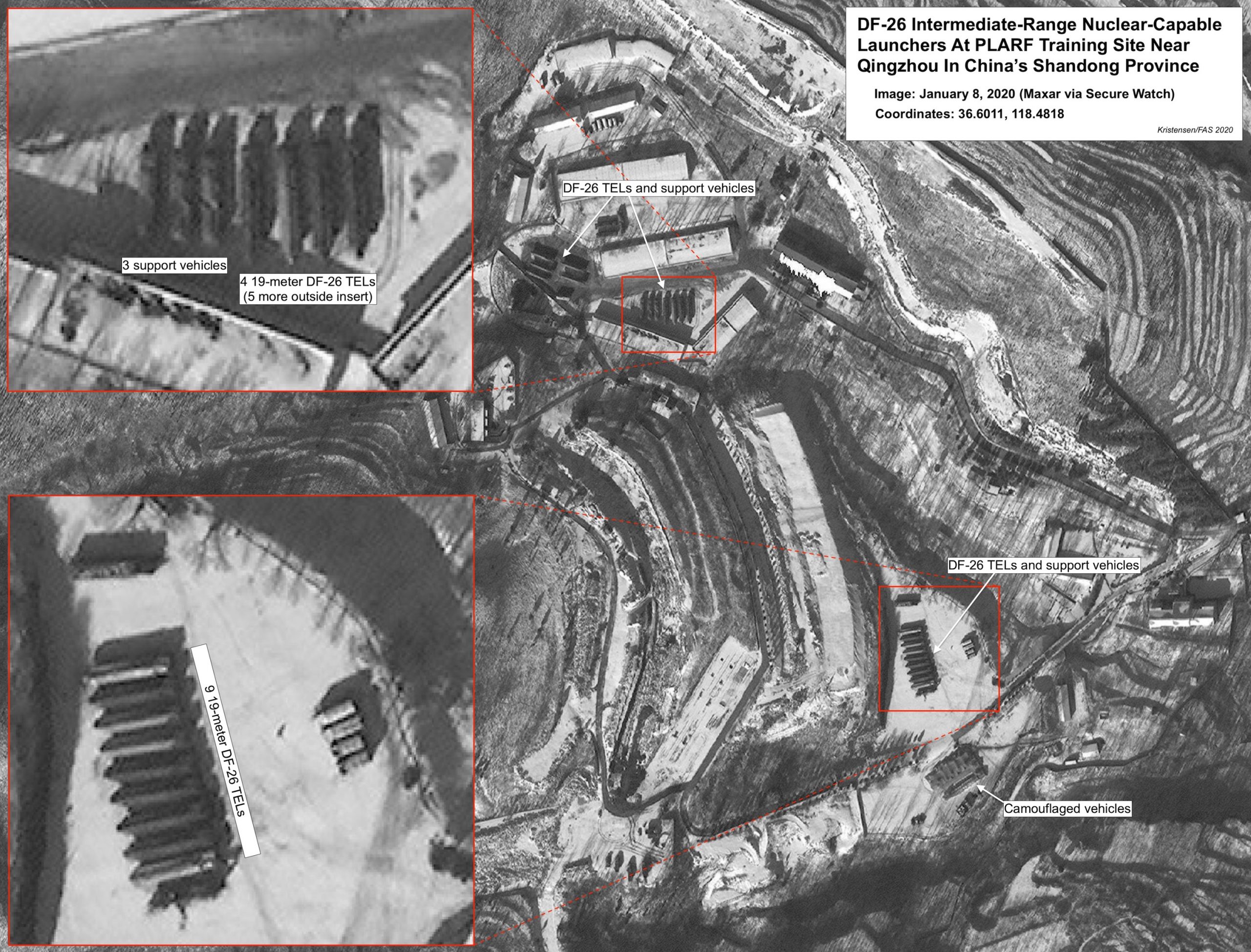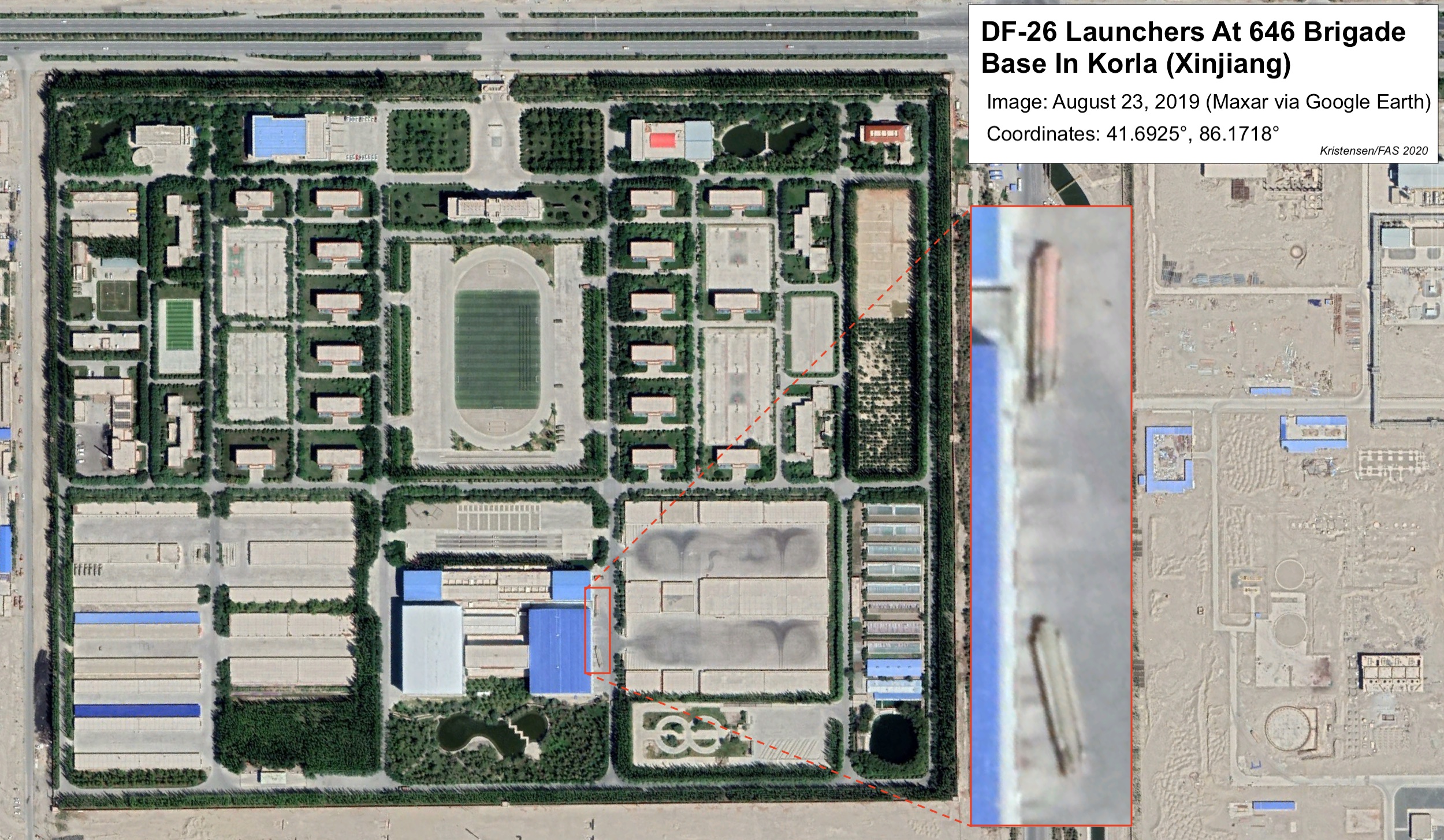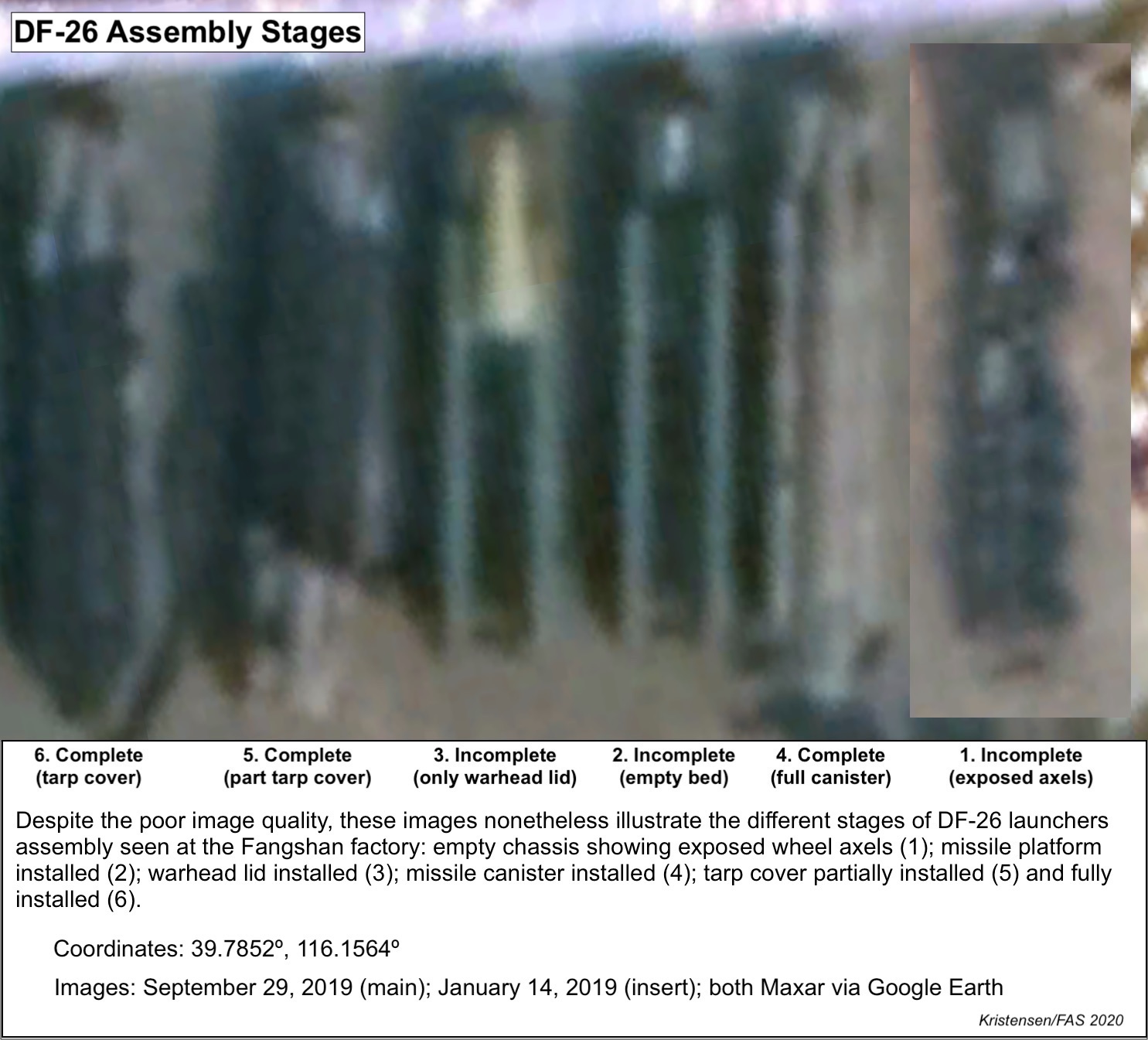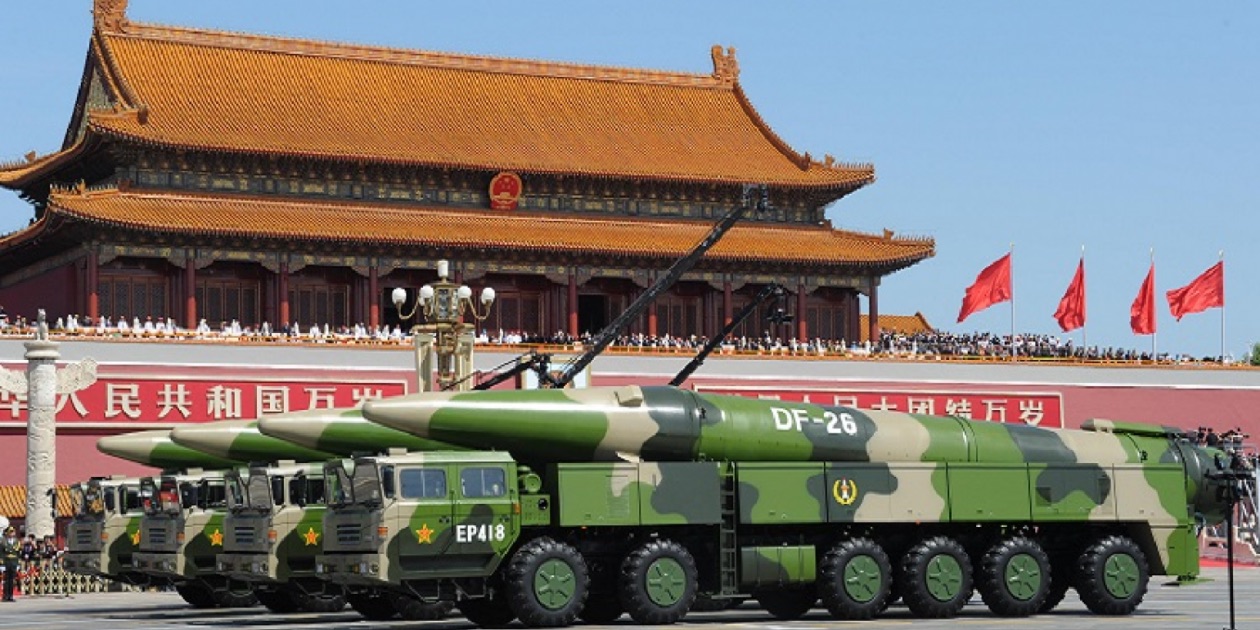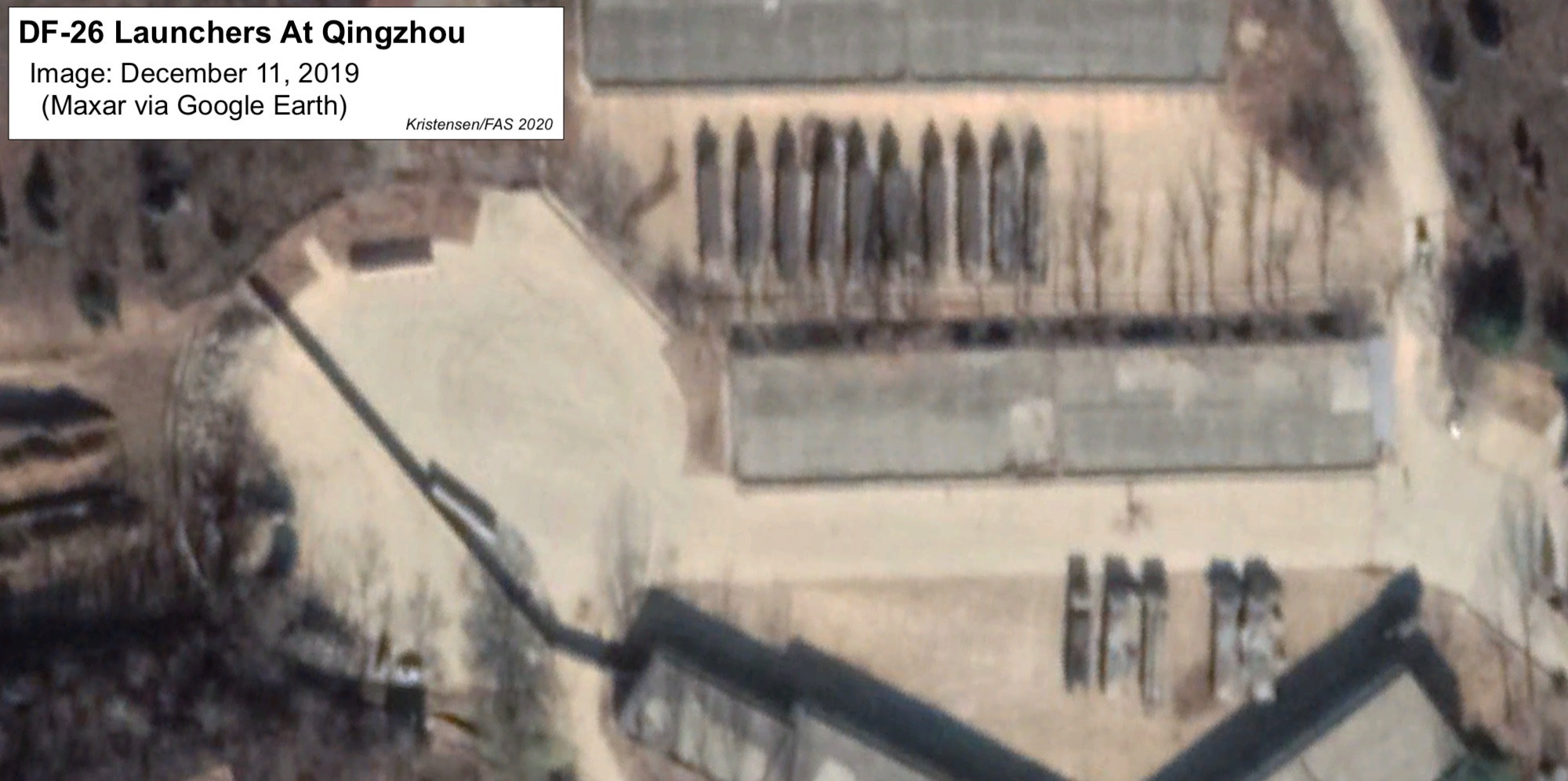
China’s New DF-26 Missile Shows Up At Base In Eastern China
Pictures taken recently by Maxar Technologies’ satellites show a large number of launchers for the DF-26 intermediate-range missile operating at a training site approximately 9 kilometers (5.7 miles) south of Qingzhou City in China’s Shandong Province.
This is the first time the DF-26 has been seen operating in the area and marks a new phase in the integration of the missile into the Chinese military. The DF-26 is dual-capable, which means it can deliver both nuclear and conventional warheads and is thought to have a range of approximately 4,000 kilometers (2,490 miles). The DF-26 was first fielded in 2016 and the Pentagon’s 2019 report on Chinese military developments estimated China has up to 80 DF-26 launchers with 80-160 missiles (each launcher may have one reload).
The DF-26 is an INF-weapons, which means its range puts it in the category of ground-launched missiles that Russia and the United States banned in their arsenals for 32 years until Russia violated the treaty and the United States withdrew in protest.
China’s first DF-26 brigade stood up in April 2018 approximately 630 kilometers (390 miles) southwest of Qingzhou outside Xinyang in Henan Province. Over the past two years, DF-26s have appeared at several locations across China and significant production is visible at a factory outside Beijing.
DF-26 Sightings At Qingzhou
The Qingzhou site has been active for many decades and appears to be part of a missile support base operated by the People’s Liberation Army Rocket Force (PLARF). CIA initially identified the location as I-TU, a misspelling of its former name Yidu County, since changed to Qingzhou. The main base is located in the southwest district of the city [36.6774°, 118.4541°] and includes three large high-bay garages for servicing missile launchers. Over the years, several nuclear missile launchers have been seen operating there: DF-3A IRBM, DF-21 SRBM, DF-31/A ICBM, and now DF-26 IRBM.
The facility where the DF-26s recently appeared is about 9 kilometers (5.7 miles) of Qingzhou to the south near a location identified on Google Earth as Zhuanghanmiaocun. The DF-26 launchers first appeared there on satellite images in November 2019, when a dozen launchers were seen. In early January 2020, Google Earth loaded a Maxar image dated December 11, 2019 (note: image dates displayed on Google Earth are for some reason one day early compared to the actual date the image was taken), which was first described by Twitter user @DexReloaded. During December, several images taken by Maxar satellites show up to 18 DF-26 launchers, approximately the same number that was displayed at Xinyang in 2018 and at Jilantai in 2019.
The most recent image dated January 8, 2020, shows two groups of DF-26 launchers: one to the north (36.6026°, 118.4803°), between garages and on an old DF-3A circular launch pad; and a second group to the south (36.5999°, 118.4835°) on a cleared space where a former DF-31 launch pad is still visible. Also visible on the image are numerous support vehicles needed to support or repair the launchers when deployed. The DF-26 launchers are probably at the site as part of their integration into a new brigade.
DF-26 Sightings Elsewhere
As mentioned above, China stood up its first DF-26 unit in 2018. An image from the activation ceremony shows 24 trucks parked under a temporary cover: 18 DF-26 TELs and 4 support vehicles. If each brigade has 18 launchers, then the 80 launchers reported by the Pentagon would be sufficient for four brigades. Not all have become operational yet but DF-26s are beginning to appear at various sites across China: Xinyang (Henan), Qingzhou (Shandong), Dengshahe (Liaoning), Korla (Xinjiang), possibly Jinhua (Anhui), and the large training area at Jilantai (Inner Mongolia).
The standing up of the first DF-26 brigade at Xinyang in April 2018 was announced on Chinese news media with pictures and videos from the ceremony. But even before that, in January 2018, DF-26 launchers showed up at the field training site of the 651st Brigade near Dengshahe northeast of Dalian (Liaoning).
Then, in January 2019, Chinese media announced that DF-26s had carried out an exercise in the “Northwest China’s plateau and desert areas.” The operation was later geo-located to the large new training area west of Jilantai (Inner Mongolia), where they continued to train in April-May 2019 together with DF-41s, DF-31AGs, and DF-17s before being shipped to Beijing for the parade in September 2019.
DF-26 training at Jilantai has been a favorite propaganda tool for the Chinese government with several test-launches shown on various news media outlets (here and here). A propaganda documentary jointly produced by the Political Bureau of the Central Military Commission and the PLA News and Communication Center and broadcast by CCTV by the end of 2019 included a brief clip showing a DF-26 launch. The launch site is geolocated in the figure below:
During those months, DF-26 launchers were also seen operating at the 646 Brigade base in Korla (Ku’erle) in the Xinjiang province in western China. The first launcher was seen in April and two more in August 2019 (see image below).
DF-26 Production And Numbers
The Pentagon estimated in 2019 that China had fielded up to 80 DF-26 launchers. Not all of those are fully operationally deployed; some brigades are still being equipped. Noted China military expert Mark Stokes estimated maybe two or three DF-26 brigades a year ago, each with 6-12 launchers. So the display of 18 launchers at Xinyang and Qingzhou is obviously interesting: did it include 6-12 launchers from a second brigade or will DF-26 brigades have more launchers?
Eighteen launchers were also the number seen operating at Jilantai.
DF-26 launchers are produced at a factory near Fangshan in the outskirt of Beijing. The factory has been expanded significantly during the past decade with several large vehicle assembly halls added. The factory also appears to be involved in the production of DF-21 MRBM launchers as well as various air-defense systems. The main parking area for DF-26 launchers is in the middle of the southern end of the complex (see image below).
The first DF-26 launcher at Fangshan appeared on satellite images in March 2009 and four or five launchers were normally visible through 2016 when deployment began. The number of visible launchers increased in late-2017 and early-2018 to 15-25, and increased in late-2018 and early-2019 to 20-38 launcher, until reaching 51 visible launchers in early September 2019. Not all of the launchers seen were fully assembled; of the 51 launchers visible in September 2019, for example, only 38 appeared to be complete. The various stages of assembly are clearly visible on the images (see image below).
How does the Pentagon’s China report get to 80 DF-26 launchers? The report doesn’t explicitly say the 80 are fielded or deployed and the operational brigades and launchers seen at training areas do not add up to 80 – that number is less than 60. It seems likely the DOD estimate includes at least some of the launchers in production at Fangshan. As illustrated above, those launchers include some that are not finished but at various stages of assembly.
If one adds up all the Fangshan launchers that appear complete (those with missile canister installed), the number was about 40 in mid-2018, when DOD reported 16-30 launchers. By mid-2019, when DOD reported 80 launchers, the total number of completed launchers at Fangshan was about 50. Such a count does not accurately show how many launchers were complete because the available images were not evenly distributed over time; some were taken only a few days or weeks apart and there were month-long gaps between others. Nonetheless, it does indicate that the DOD estimate of 80 launchers likely included complete launchers at the Fangshan factory in addition to those deployed at the brigade bases and training areas.
DF-26 Implications
The “new” about the DF-26 is not that it can target Guam (other missiles have been able to do so for decades); it is that it can do so with an accurate conventional warhead. But there are also other reasons why the deployment of additional new DF-26s at Qingzhou and other locations, as well as the considerable production that is underway, is important.
The first reason is the growing size and diversity of the Chinese nuclear arsenal. China officially maintains what it calls a minimum deterrent focused on ensuring it has a secure retaliatory capability to respond to a nuclear attack. Compared with Russia and the United States, the Chinese nuclear arsenal is small; but compared with France, Britain, and India, the Chinese arsenal is significant. And it is increasing further with China about to overtake France as the world’s third-largest nuclear-weapon state. China’s arsenal has nearly doubled over the past 15 years and is expected to increase further over the next decade, although perhaps not as much as some say. There is no indication China is seeking numerical parity (or near-parity) with Russia and the United States or changing its nuclear strategy. Yet the apparently open-ended growth of the Chinese nuclear arsenal is deepening uncertainty and anxiety in neighboring countries and other nuclear-armed states about China’s long-term intentions.
China’s rejection of such concerns is well-known but counterproductive because it will fuel the development and deployment of military capabilities that China will see as growing threats to its national security. The Chinese government could help alleviate concerns and worst-case response by issuing factual statements about the status and future plans for its nuclear arsenal. This would not require disclosing everything, but as a growing military power, the days are over when China can hide behind the larger nuclear powers.
A second reason the growing DF-26 deployment is important is that it is a dual-capable weapon that can deliver either a conventional or a nuclear warhead. The inability to clearly distinguish the two creates significant challenges for crisis stability and escalation scenarios. In a tense crisis or a war, Chinese readying of conventionally-armed DF-26 launchers could easily be misinterpreted as preparations to employ nuclear weapons and cause an adversary to ready its nuclear weapons unnecessarily and precipitately. If China launched a conventionally-armed DF-26, the target country might assume the worst and prematurely escalate to nuclear use. This dilemma is exacerbated by the fact that the conventional DF-26 is part of the PLARF’s conventional missile strike force intended to provide pre-nuclear strike options, a force that in a potential war with the United States would likely be subject to focused and intense conventional strikes. If the United States used conventional weapons to target what it perceived was conventional DF-26 launchers, China might conclude that the United States had attacked its nuclear forces and escalate accordingly.
A fourth reason the growing DF-26 deployment is important is that the payload section is guided and, according to DOD, is “capable of near-precision strike capability” against land targets. Retaliatory nuclear deterrence does not require near-precision, but warfighting could. As such, Chinese deployment of highly accurate, quick-strike, dual-capable weapons could further deepen uncertainty and speculations about Chinese nuclear strategy. It could potentially also influence Chinese considerations about sub-strategic uses of nuclear weapons in de-escalation scenarios.
Finally, the DF-26 deployment is important because the missile is part of China’s growing inventory of INF-range weapons. Russia’s violation of the INF treaty was probably partially a response to China’s growing inventory of INF-range missiles, and the United States used China as part of its justification for withdrawing from the INF treaty and is developing several INF missiles that it plans to deploy within range of China. Russian and US deployment of INF missiles near China will likely further stimulate China’s production of INF-range weapons and potentially result in a destabilizing INF arms race in the Pacific.
For these reasons, it is important that China provides more information about its future plans for the development of its missile forces and engage in ongoing official discussions about the scope and role of its nuclear deterrent, including INF forces. And although China is unlikely to join US-Russian strategic agreements in the foreseeable future, Beijing should already now begin to develop options for what it could offer and what it would want in return if joining such agreements in the future. This could include articulating which US (and Indian) capabilities China is most concerned about and what Beijing would offer in return for limits on them. As a goodwill gesture, China could also offer unilateral limits on its INF capabilities in return for the US and Russia not deploying new INF systems in the region. Information and limits on the dual-capable DF-26 would be a good start.
This publication was made possible by generous contributions from the Carnegie Corporation of New York, the John D. and Catherine T. MacArthur Foundation, the New Land Foundation, the Ploughshares Fund, and the Prospect Hill Foundation. The statements made and views expressed are solely the responsibility of the authors.
Satellite imagery has long served as a tool for observing on-the-ground activity worldwide, and offers especially valuable insights into the operation, development, and physical features related to nuclear technology.
This report outlines a framework relying on “Cooperative Technical Means” for effective arms control verification based on remote sensing, avoiding on-site inspections but maintaining a level of transparency that allows for immediate detection of changes in nuclear posture or a significant build-up above agreed limits.
The grant comes from the Carnegie Corporation of New York (CCNY) to investigate, alongside The British American Security Information Council (BASIC), the associated impact on nuclear stability.
Satellite imagery of RAF Lakenheath reveals new construction of a security perimeter around ten protective aircraft shelters in the designated nuclear area, the latest measure in a series of upgrades as the base prepares for the ability to store U.S. nuclear weapons.
